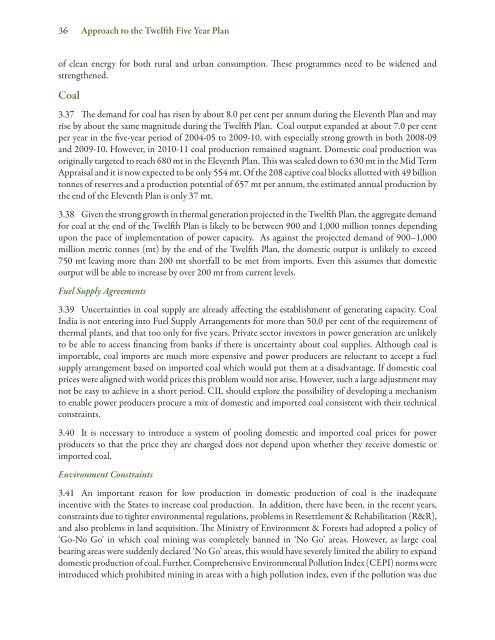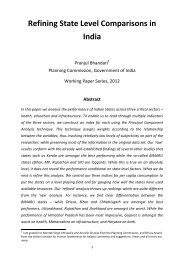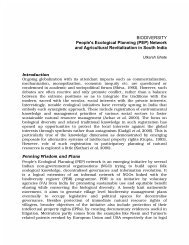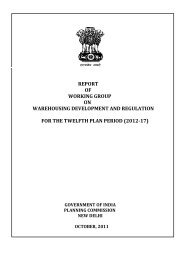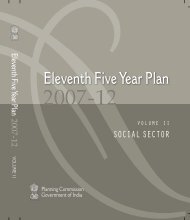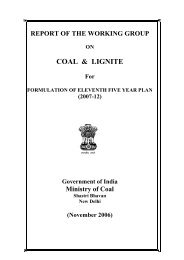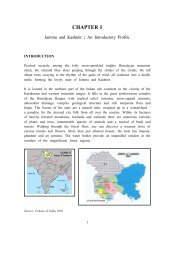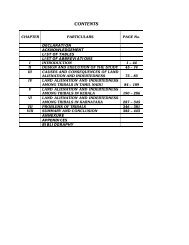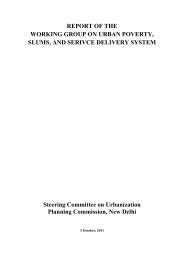Approach Paper for the Twelfth Five Year Plan - of Planning ...
Approach Paper for the Twelfth Five Year Plan - of Planning ...
Approach Paper for the Twelfth Five Year Plan - of Planning ...
Create successful ePaper yourself
Turn your PDF publications into a flip-book with our unique Google optimized e-Paper software.
36 <strong>Approach</strong> to <strong>the</strong> <strong>Twelfth</strong> <strong>Five</strong> <strong>Year</strong> <strong>Plan</strong><br />
<strong>of</strong> clean energy <strong>for</strong> both rural and urban consumption. These programmes need to be widened and<br />
streng<strong>the</strong>ned.<br />
Coal<br />
3.37 The demand <strong>for</strong> coal has risen by about 8.0 per cent per annum during <strong>the</strong> Eleventh <strong>Plan</strong> and may<br />
rise by about <strong>the</strong> same magnitude during <strong>the</strong> <strong>Twelfth</strong> <strong>Plan</strong>. Coal output expanded at about 7.0 per cent<br />
per year in <strong>the</strong> five-year period <strong>of</strong> 2004-05 to 2009-10, with especially strong growth in both 2008-09<br />
and 2009-10. However, in 2010-11 coal production remained stagnant. Domestic coal production was<br />
originally targeted to reach 680 mt in <strong>the</strong> Eleventh <strong>Plan</strong>. This was scaled down to 630 mt in <strong>the</strong> Mid Term<br />
Appraisal and it is now expected to be only 554 mt. Of <strong>the</strong> 208 captive coal blocks allotted with 49 billion<br />
tonnes <strong>of</strong> reserves and a production potential <strong>of</strong> 657 mt per annum, <strong>the</strong> estimated annual production by<br />
<strong>the</strong> end <strong>of</strong> <strong>the</strong> Eleventh <strong>Plan</strong> is only 37 mt.<br />
3.38 Given <strong>the</strong> strong growth in <strong>the</strong>rmal generation projected in <strong>the</strong> <strong>Twelfth</strong> <strong>Plan</strong>, <strong>the</strong> aggregate demand<br />
<strong>for</strong> coal at <strong>the</strong> end <strong>of</strong> <strong>the</strong> <strong>Twelfth</strong> <strong>Plan</strong> is likely to be between 900 and 1,000 million tonnes depending<br />
upon <strong>the</strong> pace <strong>of</strong> implementation <strong>of</strong> power capacity. As against <strong>the</strong> projected demand <strong>of</strong> 900–1,000<br />
million metric tonnes (mt) by <strong>the</strong> end <strong>of</strong> <strong>the</strong> <strong>Twelfth</strong> <strong>Plan</strong>, <strong>the</strong> domestic output is unlikely to exceed<br />
750 mt leaving more than 200 mt shortfall to be met from imports. Even this assumes that domestic<br />
output will be able to increase by over 200 mt from current levels.<br />
Fuel Supply Agreements<br />
3.39 Uncertainties in coal supply are already affecting <strong>the</strong> establishment <strong>of</strong> generating capacity. Coal<br />
India is not entering into Fuel Supply Arrangements <strong>for</strong> more than 50.0 per cent <strong>of</strong> <strong>the</strong> requirement <strong>of</strong><br />
<strong>the</strong>rmal plants, and that too only <strong>for</strong> five years. Private sector investors in power generation are unlikely<br />
to be able to access financing from banks if <strong>the</strong>re is uncertainty about coal supplies. Although coal is<br />
importable, coal imports are much more expensive and power producers are reluctant to accept a fuel<br />
supply arrangement based on imported coal which would put <strong>the</strong>m at a disadvantage. If domestic coal<br />
prices were aligned with world prices this problem would not arise. However, such a large adjustment may<br />
not be easy to achieve in a short period. CIL should explore <strong>the</strong> possibility <strong>of</strong> developing a mechanism<br />
to enable power producers procure a mix <strong>of</strong> domestic and imported coal consistent with <strong>the</strong>ir technical<br />
constraints.<br />
3.40 It is necessary to introduce a system <strong>of</strong> pooling domestic and imported coal prices <strong>for</strong> power<br />
producers so that <strong>the</strong> price <strong>the</strong>y are charged does not depend upon whe<strong>the</strong>r <strong>the</strong>y receive domestic or<br />
imported coal.<br />
Environment Constraints<br />
3.41 An important reason <strong>for</strong> low production in domestic production <strong>of</strong> coal is <strong>the</strong> inadequate<br />
incentive with <strong>the</strong> States to increase coal production. In addition, <strong>the</strong>re have been, in <strong>the</strong> recent years,<br />
constraints due to tighter environmental regulations, problems in Resettlement & Rehabilitation (R&R),<br />
and also problems in land acquisition. The Ministry <strong>of</strong> Environment & Forests had adopted a policy <strong>of</strong><br />
‘Go-No Go’ in which coal mining was completely banned in ‘No Go’ areas. However, as large coal<br />
bearing areas were suddenly declared ‘No Go’ areas, this would have severely limited <strong>the</strong> ability to expand<br />
domestic production <strong>of</strong> coal. Fur<strong>the</strong>r, Comprehensive Environmental Pollution Index (CEPI) norms were<br />
introduced which prohibited mining in areas with a high pollution index, even if <strong>the</strong> pollution was due


